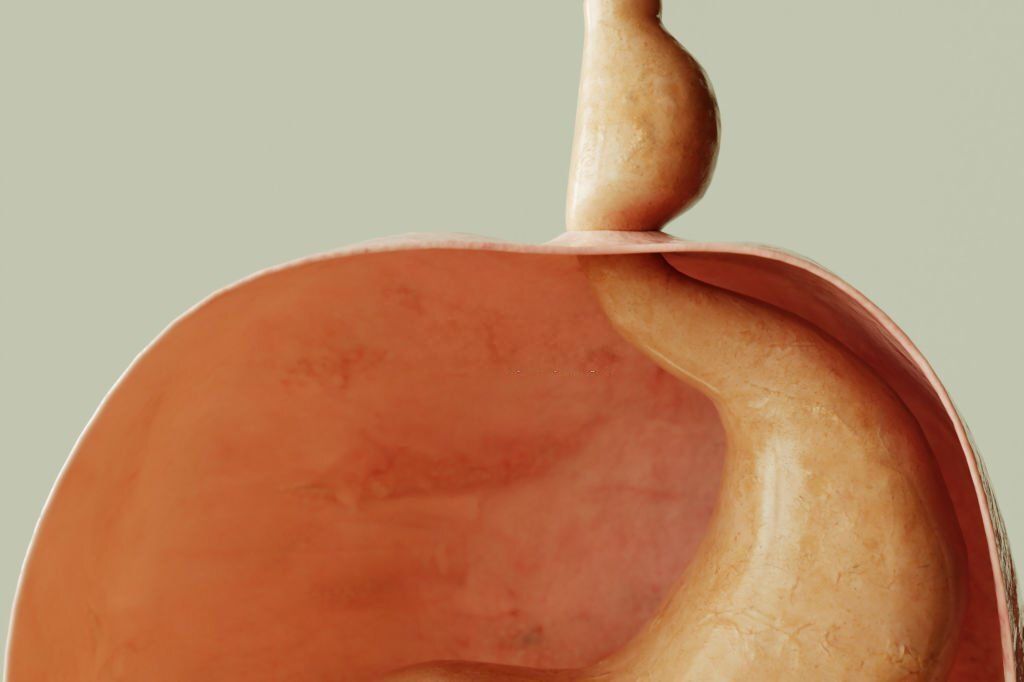This article is reviewed, corrected, and approved by: Dr. Benjamin McLean M.D. | FCPS | FRCP | MPH
Hiatal hernias can cause pain and discomfort and affect daily life. Understanding this condition is crucial for timely intervention and effective management.
Today, I will shed light on the overview of hiatal hernias, delve into the causes and risk factors, discuss common symptoms, and some crucial factors about hernia surgery. Moreover, I will also explore various treatment options. So, let’s dive in.
Overview of Hiatal Hernia
When someone has a hiatal hernia, part of their stomach moves up into their chest through a small opening in their diaphragm. It's a medical condition that can cause discomfort and other symptoms.
Hiatal hernia is classified into two types:
- Sliding hiatal hernias
- Paraesophageal hiatal hernias.
Hiatal hernias are the most common, characterized by the stomach temporarily moving up into the chest when a person swallows. Paraesophageal hernias involve a structural abnormality where the stomach bulges up beside the esophagus.
Causes of Hiatal Hernia
Several factors are responsible for hiatal hernias. Such as age, as the condition tends to occur more frequently with aging, and certain lifestyle habits such as obesity, smoking, and frequent heavy lifting.
Additionally, prolonged or increased pressure on the abdomen, such as during pregnancy or persistent coughing, can also contribute to the formation of hiatal hernias (hernia icd 10).
Hiatal Hernias Types
A. Small Hiatal-Hernias
Definition and Characteristics: This type of hiatal hernia generally occurs when our stomach protrudes through the diaphragmatic opening into the chest cavity. They are usually asymptomatic or cause mild symptoms like heartburn. Diagnosis involves imaging techniques like endoscopy or upper GI series.
B. Moderate Hiatal Hernias
Definition and Characteristics: Moderate hiatal hernias involve a larger portion of the stomach protruding through the hiatus. These types of hernias can really make you feel uncomfortable, giving you symptoms such as heartburn, regurgitation, chest pain, and even difficulty swallowing.
C. Large Hiatal Hernias
Definition and Characteristics: Large hiatal hernias involve a substantial portion of the stomach or other abdominal organs. This type can cause severe symptoms such as shortness of breath, chest pain, and significant reflux. They may also lead to complications like volvulus or obstruction.
D. Giant Hiatal Hernias
Definition and Characteristics: Giant hiatal hernias, also known as paraesophageal hernias, are the most severe type of hiatal hernia. In these cases, a significant portion of the stomach, or sometimes other abdominal organs, moves into the chest cavity beside the esophagus. Symptoms like difficulty swallowing, even respiratory problems like asthma, wheezing, etc. and chest pain.
Symptoms and Diagnosis
Common symptoms of hiatal hernia are chest pain, inflammation in the heart, regurgitation, feeling full fast, and difficulty swallowing. Some individuals may experience no noticeable symptoms. Diagnostic procedures like medical history assessment, physical examination, imaging tests (X-ray, barium swallow, CT scan), endoscopy, pH monitoring aid, etc.
How To Prevent Hernia and Treatment Options
Treatment for hiatal hernias (hernia icd 10) varies depending on the size, severity of symptoms, and associated complications. Non-surgical approaches include lifestyle modifications (such as avoiding large meals, elevating the head while sleeping, and weight loss), dietary changes, and medications to control acid reflux.
The decision to proceed with surgery is typically based on the size of the hernia, severity, and frequency of symptoms, complications, and the overall health of the patient. Surgical procedures like laparoscopic Nissen fundoplication or hernia repair aim to restore the anatomical position of the stomach and alleviate symptoms.
A. Small Hiatal Hernias Non-Surgical Treatment Options
Lifestyle, habit change, and medications can help manage symptoms of small hiatal hernias without surgery. Maintaining a healthy weight, avoiding large meals, raising the head of the bed, and taking antacids, PPIs, or H2 blockers can provide relief by reducing stomach acid production and alleviating acid reflux symptoms.
B. Moderate Hiatal Hernias Non-Surgical Treatment Options
Surgery can be an option for moderate hiatal hernias if other treatments don't work or if complications arise. Hernias should also be surgically treated if they involve significant impairment of quality of life or pose a threat of strangulation, whereby the herniated stomach becomes trapped and the blood supply is damaged.
C. Large Hiatal Hernia Surgical Considerations and Treatment Options
For large hiatal hernias, surgery is recommended to prevent complications. The procedure involves reducing the organs and reinforcing the hiatus. Laparoscopy is used as a treatment option.
D. Surgical Intervention as the Primary Treatment
Surgery is the main treatment for giant hiatal hernias. Emergency surgery may be necessary if there's a risk of complications. The surgical procedure involves fixing the hernia and securing the stomach in its proper place, usually through a minimally invasive procedure.
What Size Hiatal Hernia Needs Surgery?

Deciding whether surgery is necessary for a hiatal hernia is a complex process. Surgery basically depends on the size and severity of the hiatal hernia, and there are many factors to consider here. Hernias larger than 5 cm are more likely to require surgery due to the increased risk of complications.
Smaller hernias can also cause problems if they lead to notable symptoms. Other factors, like the type of hernia and its impact on the patient's daily life, are also considered. There are two techniques available for performing surgeries: laparoscopic and open.
Source: https://www.ncbi.nlm.nih.gov/pmc/articles/PMC3925867/
Hiatal hernias are classified into different types based on their severity:
- Type 1 (Sliding Hiatal Hernia): It is known as the most common one. Symptoms often include gastroesophageal reflux disease (GERD).
- Type 2, 3, and 4 (Paraesophageal Hernias): These are variations of paraesophageal hernias that involve more significant protrusions of the stomach and other organs into the chest cavity.
While larger hernias are actually likely to cause more complications. Surgery is determined based on a variety of factors, including the type of hernia, symptoms experienced, and the overall health of the patient.
Self-Care Techniques for Coping with Hiatal Hernia Symptoms at Home
Reducing the risk and alleviating symptoms of hiatal hernias can be achieved by adopting certain habits. You cannot completely prevent it eventually. Maintaining a healthy weight, avoiding tobacco use, practicing good posture, and eating smaller, more frequent meals can help manage symptoms.
Avoiding trigger foods (e.g., spicy or fatty foods, caffeine) can help reduce the likelihood of complications. But keep in mind if you experience any serious symptoms, home treatment might not be a good option. You need to go to a doctor or gastroenterologist as early as possible.
Conclusion
Now you know the detailed answer to the question: What Size Hiatal Hernia Needs Surgery? The decision for hernia surgery depends on size, severity, and symptoms. Having knowledge about hiatal hernias can help individuals identify symptoms timely, seek medical assistance, and help to find appropriate treatment alternatives.
With timely care, anyone can be cured of a hernia. Don't hesitate to seek treatment and explore appropriate options which are near you.
Hiatal Hernias and Surgery
- Overview of Hiatal Hernia:
- Stomach moves into chest through diaphragm opening.
- Two types: Sliding and Paraesophageal.
- Causes and Risk Factors:
- Age, lifestyle habits (obesity, smoking), heavy lifting.
- Pressure on abdomen (pregnancy, persistent coughing).
- Types of Hiatal Hernias:
- Small, Moderate, Large, Giant (Paraesophageal).
- Symptoms and Diagnosis:
- Chest pain, heartburn, regurgitation, swallowing difficulty.
- Diagnosis: Medical history, physical exam, imaging tests.
- Prevention and Non-Surgical Treatment:
- Lifestyle changes, dietary adjustments, medications.
- Tailored to hernia size, symptoms, and complications.
- Surgical Considerations:
- Based on size, severity, and impact on quality of life.
- Procedures: Laparoscopic or open surgery.
- Size and Surgery:
- Larger hernias (≥5 cm) more likely to require surgery.
- Type and impact on daily life also considered.
- Self-Care Techniques:
- Maintain healthy weight, posture, smaller meals.
- Avoid trigger foods, seek medical help for serious symptoms.
F.A.Qs
Q: Can a hiatal hernia cause back pain
Ans: Yes, a hiatal hernia can sometimes cause back pain.
Q: Does weight loss typically occur after hiatal hernia surgery?
A: Yes, weight loss can be a common effect after hiatal hernia surgery, similar to some other surgical procedures.
Q: How much does hiatal hernia surgery cost in general?
Ans: The cost of hiatal hernia surgery varies widely depending on factors like location, hospital, surgeon, and insurance coverage.


